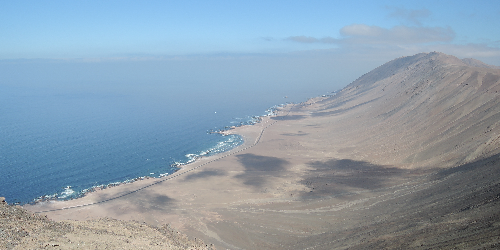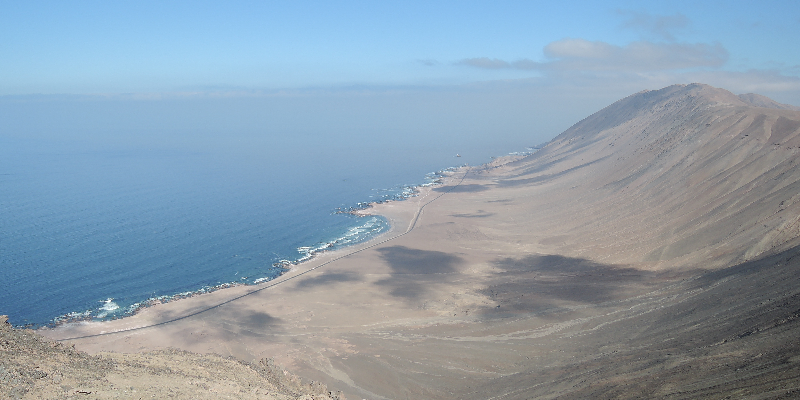Seismic Waves Feel the Moon’s Tug
If you want to measure how the mechanical properties of complex natural rock formations change under physical stress, neither lab tests on small samples nor measurements in the field can do a complete job. Researchers now report that a new technique can provide information on rock properties from long-term recording of ambient seismic noise at a single monitoring station. The data reveal the effects of periodic stresses resulting from the gravitational pulls of the Moon and the Sun as well as from solar heating. Tracking subsurface conditions in this way could be important in following natural geological processes and in safeguarding construction and mining operations.
Heterogeneous materials such as rocks and minerals typically have elastic properties that change when the material is distorted (strained) by external forces. This change in elastic properties alters the speed at which seismic waves travel through the rock. For several decades, researchers have attempted to use variations in seismic velocity as a diagnostic of geophysical conditions, but experiments have proven difficult. Active source measurements, in which researchers set off seismic disturbances and observe waves at several stations, have yielded good results, but their cost and organizational requirements make them impractical for routine monitoring. Other researchers have measured ambient seismic noise at networks of existing seismic stations but have not obtained precise information.
Christoph Sens-Schönfelder of the GFZ German Research Centre for Geosciences in Potsdam and Tom Eulenfeld of Friedrich Schiller University in Jena, Germany, tried a new observational method in which they analyzed 11 years’ worth of data from a single source, the Patache seismic station in the Atacama Desert of northern Chile. The measured vibrations came from naturally occurring seismic noise produced, among other things, by the impact of ocean waves on the nearby Pacific coast.
The researchers analyzed the seismic recordings with a so-called autocorrelation technique, a procedure that revealed seismic waves that struck the detector and then reflected back off the surroundings and hit the detector again—a bit like listening for echoes in a church, says Schönfelder. Mathematical analysis of the echo patterns enabled the researchers to see how the velocity of seismic waves changed from one moment to the next.
A plot of the velocity variations over the full 11-year observing period showed a clear annual oscillation with an amplitude representing about half a percent change in the seismic wave speed. This signal was punctuated by a few larger jumps coinciding with earthquakes. Closer examination of the data revealed smaller oscillations with periods of exactly one day and about half a day; the latter actually consisted of two separate signals, with periods of roughly 12.42 and 12.65 hours. The 12.42-hour period, which showed a seismic velocity variation of 0.026%, is exactly that of the main lunar tidal influence—the periodic distortions of the Earth attributable to the Moon’s gravitational pull. The longer period corresponds to a secondary tidal effect that comes from the slight ellipticity of the Moon’s orbit.
To verify these associations, the researchers estimated the strain on rocks produced by the lunar and solar tidal forces. They found that the amplitudes of the predicted strain oscillations were proportional to the amplitudes of the roughly 12-hour seismic velocity oscillation signals, further supporting the idea that the tidal strain affected rock properties.
But the daily oscillation was different. Although there is a solar tidal effect linked to the Earth’s daily rotation, it is much smaller than the lunar effect and insufficient to explain the seismic signal that had a one-day period. The researchers concluded that the daily variation is instead associated with heating and cooling of the Earth’s surface, which also has a period of one day. Intriguingly, the analysis also showed small signals clustered around frequencies that are sums and differences of the lunar and solar signals, a classic sign that two effects with different natural frequencies are interacting in some way.
Tom Daley, a geoscientist now retired from Lawrence Berkeley National Laboratory in California, says that the new study’s use of a single station monitoring background noise is novel and that the precision it achieves is “the best I’ve seen.” The method could be used almost anywhere, he says, and a potential next step would be to look for differences among various types of rock material. Sens-Schönfelder and Eulenfeld suggest the technique could even be incorporated into planetary probes, since only one location is needed.
This research is published in Physical Review Letters.
–David Lindley
David Lindley is a freelance science writer in Alexandria, Virginia.





